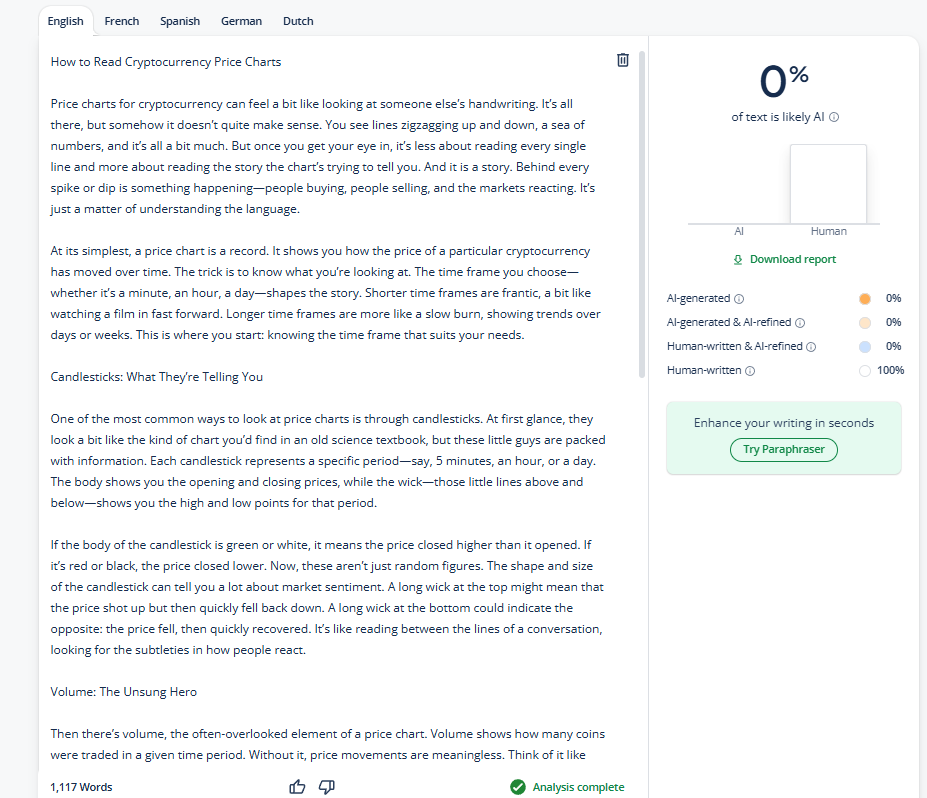How to Read Cryptocurrency Price Charts

Price charts for cryptocurrency can feel a bit like looking at someone else’s handwriting. It’s all there, but somehow it doesn’t quite make sense. You see lines zigzagging up and down, a sea of numbers, and it’s all a bit much. But once you get your eye in, it’s less about reading every single line and more about reading the story the chart’s trying to tell you. And it is a story. Behind every spike or dip is something happening—people buying, people selling, and the markets reacting. It’s just a matter of understanding the language.
At its simplest, a price chart is a record. It shows you how the price of a particular cryptocurrency has moved over time. The trick is to know what you’re looking at. The time frame you choose—whether it’s a minute, an hour, a day—shapes the story. Shorter time frames are frantic, a bit like watching a film in fast forward. Longer time frames are more like a slow burn, showing trends over days or weeks. This is where you start: knowing the time frame that suits your needs.
Candlesticks: What They’re Telling You
One of the most common ways to look at price charts is through candlesticks. At first glance, they look a bit like the kind of chart you’d find in an old science textbook, but these little guys are packed with information. Each candlestick represents a specific period—say, 5 minutes, an hour, or a day. The body shows you the opening and closing prices, while the wick—those little lines above and below—shows you the high and low points for that period.
If the body of the candlestick is green or white, it means the price closed higher than it opened. If it’s red or black, the price closed lower. Now, these aren’t just random figures. The shape and size of the candlestick can tell you a lot about market sentiment. A long wick at the top might mean that the price shot up but then quickly fell back down. A long wick at the bottom could indicate the opposite: the price fell, then quickly recovered. It’s like reading between the lines of a conversation, looking for the subtleties in how people react.
Volume: The Unsung Hero
Then there’s volume, the often-overlooked element of a price chart. Volume shows how many coins were traded in a given time period. Without it, price movements are meaningless. Think of it like this: a price movement up or down is just a change in number. But when volume backs that movement up, you get a sense of the real power behind it. If the price is going up but volume is low, you’ve got to wonder: who’s driving this? On the flip side, high volume with a price increase is usually a good sign that there’s genuine interest. It’s the difference between a flash in the pan and a sustained trend.
This is where your instincts come in. If the market’s moving and volume is there, it’s more likely to continue. If the market’s moving and there’s no volume, it’s like a door closing in a hallway—you’ll hear it, but it won’t last long. For anyone paying attention to USD to BTC, the exchange rate between the US dollar and Bitcoin, volume plays a major role here too. Watching how much Bitcoin is traded for dollars gives you an idea of where the market might be heading. Low volume often means caution; high volume, on the other hand, could be the green light to get involved.
Support and Resistance: Knowing When to Hold Your Ground
Next up, we have support and resistance levels. These terms can sound a bit technical, but they’re really quite simple. Think of support as the floor and resistance as the ceiling. Support is the price level at which a coin tends to stop falling and starts bouncing back up. Resistance is the price level at which it can’t seem to break through before falling back down. These levels are important because they act like psychological barriers. Traders expect the price to behave in certain ways when it hits these levels.
The trick is to spot them before the rest of the trading crowd does. If the price bounces off a support level multiple times, that’s a solid indication it’s a significant point. If it breaks through resistance, you might see the price shoot up. But there’s a catch: support and resistance aren’t always as solid as they seem. They’re not made of bricks and mortar, they’re made of human emotion. So, while these levels can guide you, don’t assume they’re set in stone.
Patterns: Not the Big Reveal You Think
There are plenty of patterns that crop up in price charts: head and shoulders, triangles, flags, and all sorts of other shapes that sound like they belong in an art gallery. While these patterns are useful, they shouldn’t be taken as gospel. A “head and shoulders” pattern suggests a price reversal might be coming, but that doesn’t mean it will. A triangle pattern often precedes a breakout, but again, it’s no guarantee.
The trick with these patterns is to wait for confirmation. Don’t jump in just because you think you’ve spotted something. Let the chart prove it to you first.
Timing: The Art of Waiting
The best traders don’t necessarily know when to buy, but they do know when to wait. A price chart can give you all the information you need, but timing is key. If the price is rising quickly, it might be tempting to jump in. But quick rises are often followed by quick falls. The trick is to be patient and wait for the chart to show you where it’s headed. Jumping in too early is like getting on a train before it leaves the station—there’s a good chance it’s going to leave you behind.
Timing also depends on what you’re looking for in the market. If you’re in for the long haul, small fluctuations might not matter as much. But if you’re a day trader, every minute counts. Knowing when to enter and exit the market is as much about experience as it is about observation. So, give the chart time to tell its story.
FAQ: Reading Cryptocurrency Price Charts
Q: What’s the most important thing to look at on a price chart?
A: The most important thing is to understand the overall trend—whether the market is moving up, down, or sideways. Candlesticks, volume, and support/resistance levels will help you spot these trends early.
Q: How do I know if a price movement is meaningful?
A: Check the volume. Price movements backed by high volume are more likely to continue, while movements with low volume can be short-lived.
